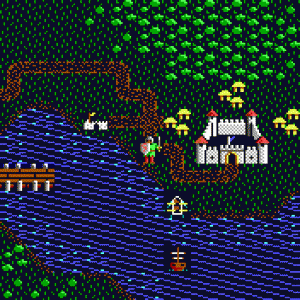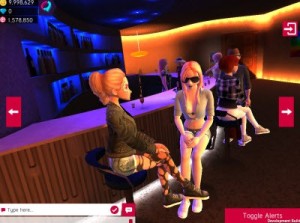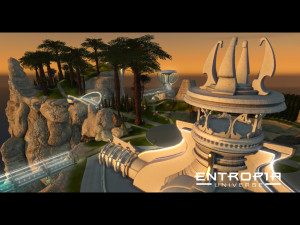How Important Are A Social MMO’s Graphics?
by NorseGamer, HSM Founder
It’s impossible to overlook the fact that the gaming industry is shifting about as hard as that Yellowstone supervolcano eruption that the History Channel keeps warning us about. And everyone is, to borrow from Spencer Johnson, trying to figure out where the cheese got moved to.
On one hand, you’ve got some prominent developers pumping roughly the GDP of Luxembourg into the latest iteration of their hit IPs. And why not? From a business standpoint, it makes sense to milk a formula for as long as you can while you try to figure out what the next formula will be. And it is a dizzying spiral booster climb of graphical superiority: the constant push to have graphics which are so photorealistic that they make the real world look like Howdy Doody by comparison.
–And on the other hand, you’ve got games like Angry Birds, Fruit Ninja and Subway Surfers, all downloaded tens of millions of times, were a fraction of the development cost, and monetized like a bank bailout. Because now we all have smartphones, and so rather than put up with the glum bum glaring at you on the bus, or read some inane article on a bleached starlet you’ve never heard of while waiting at the dentist’s office, you whip out the phone and load up something simple, fun, distracting and with no strings attached, and to hell with a Michael Bay budget for the graphics.
Which brings us to an interesting question: what of the social MMO?
There are several social MMO experiences out there. IMVU. Entropia. Second Life. Onverse. Twinity. And, of course, Home. Home definitely has a lot going for it: it’s on a game console — so there isn’t any direct competition with what it offers — and occasionally ties in with some pretty major outside IPs from the gaming and cinema worlds. And, graphically, none of the aforementioned comparables can touch it.
How important are graphics, though? Certainly less detailed graphics haven’t forced a shutdown of the other social MMOs listed above. Granted, those other worlds boast an array of features which are missing from Home, such as internal currency exchange and user-generated content. This isn’t exactly a new debate — one of the advantages of the way Home is set up is that there’s a good level of quality control on what gets published — but it does bring to light a behavioral question that no one’s really quite answered:
What draws the social gamer to a particular MMO experience?
And, once there, why do they stay — and why do they monetize?
These questions have to be asked, and answered, whenever a new MMO arrives. Currently, the latest experiment is Lockwood’s Avakin. Graphically, it’s not on par with Home — but it appears to be more or less on par with a typical social MMO. And it has the advantage of being designed specifically for mobile platforms, which to my knowledge no one else has really tried yet. So, on a mobile platform, where graphics are expected to be inferior to a game console or PC rig, what’s going to motivate someone to stare at a mobile platform such as a tablet or phone for an extended period of time? And if graphics aren’t a primary motivating factor, then what’s going to appeal to the typical social MMO gamer?
Personally, I don’t think graphics are nearly as critical as consequences.
Here’s what I mean. As a kid, I played Richard Garriott’s Ultima titles religiously. Every choice had a consequence because of the virtues system. And now, some thirty years or so later, Garriott’s back with Shroud of the Avatar. It’s written in Unity, as a lot of titles are these days (including Avakin and LOOT’s own Forsaken Planet), and thus it’s not the most graphically insane title ever created. But it doesn’t have to be, because what it’s selling are choices and consequences. It’s selling immersion. And immersion, on the player’s own time and schedule, is what consistently works as a behavioral trigger.
My own opinion is that a truly compelling social MMO doesn’t need to be a graphics powerhouse; it just has to make me truly feel like I’m part of a living, breathing, dynamic world that changes and evolves whether I’m there or not there. This creates the urgency for me to want to keep revisiting it. And nearly every single choice I make should have some sort of consequence attached to it. Granted, this requires massive amounts of database programming to enact, but without that work you end up with a social metaverse that has no purpose — which has been one of the primary consumer criticisms of Home over the years.
Imagine — just imagine — a Home which had an internal currency and a wide array of jobs to perform. How much more compelling an experience would it be? Indeed, had such a Home been brought to market five years ago, with the level of graphical capabilities currently built into it, how might it have been received differently by the gaming community at large?
There’s been no shortage of study applied to what people look for in a social MMO. Generally speaking, they purchase what can be termed as “relatable luxury” — something they want in real life but don’t have the means to acquire. LOOT’s Hollywood Hills House is an example of this. Lockwood’s Dream Yacht is another example. And this behavioral trigger is the same, regardless of the level of graphics served up by the platform. But what’s equally important to long-term user retention is the sense of relevancy; the idea that everything — every microtransaction, every space visited, every game played — in some way adds up to something greater.
And you don’t need fancy graphics to achieve that.
PlayStation Home is a remarkable experiment which continues to grow, expand and mature; given that its target audience is basically the entire Sony Entertainment Network, Home has to try to wear a lot of hats. And the graphics are already there. So now, after 2012 being the Year of the Game, it’s time to really study how to monetize the social aspects of Home with product and service design. Because a socially immersive world is a world which creates the one thing that drives sales, user retention and longer user session lengths: excitement.
Share
| Tweet |






 LinkedIn
LinkedIn Twitter
Twitter
I wholeheartedly agree. I learned from the early years of gaming that graphics are not the be-all and end-all of games, but playability and (as you’ve said) a reason to properly immerse yourself in another world. Take Gurk for example, never heard of it? No surprise. It’s a little smartphone game that wasn’t made too long ago, but anyone that looks at a screenshot of it would guess it came from the 1980’s. It’s a mini RPG, and has a fun leveling system and does the whole “better and better weapons and armour” thing nicely. There’s no major flare or whizz-bangery here, just a distilled, pure RPG game -- and it’s free. It’s also obe if the best smartphone games I’ve ever played -- ever!
The F2P (free-to-play) system works because it gives the consumer much more than just a free trial, it lets them stay in a world without obligation to pay. But of course as all core Home users know, to properly enrich that experience, it’s best to invest in a few fun things along the way if you plan on staying.
I’m not sure how Home would fare with an internal currency system, it’s a very interesting (and thought provoking) question…
Granzella has a work for pay system in place in Japan with their Neon Downtown area. It is very popular there I am still hoping it will show up here soon. The new bartender outfits are an indicator to me that they may bring it here as it features a bar there.
Graphics are important to me, I have loved watching as games have gone from a blip on a screen being batted around to what we have today. Home is a wonderful place for this, and I don’t see why we can’t have both graphics and what you are suggesting. As our gaming consoles evolve and begin to sustain larger memory capabilities like the PS4 is going to have why not have the best of both worlds. At this point I think the graphics are a big selling point for Home, but that is because as you say there is no real point or goals to achieve here unless you make up your own agenda, which many have with the limits Home has to offer. Adding more to immerse people into the environment would definitely attract attention. Great read as always Norse.
I personally enjoy high level details to enhance the immersion experience. Clothing is a great example. Beyond basics, the finer details like lace, sparkle, metallic, leather and matte textures make the clothing appear more realistic…and thereby more desirable for purchase. Most of the dance locomotions create a natural fluidity of movement that gives the user a sense of attitude and tone beyond their ‘chat bubbble.’
Detail in spaces also invites a lot of exploration and feedback. Subtle beauty, light/shadow and even the presence of weather patterns make for picturesque environments that literally set the mood for a space…and can make for some nice photo ops
Graphics aren’t everything. Journey had very basic graphics. Straight tones. Then of course there was the goal and what it took to get there.
Damn good example of what a social MMO should be.
I guess the trick is setting new goals when the old ones have been completed. A different journey. Maybe in a different form.
Burbie’s right. Neon Downtown in Japan is cool. A place to work, and places to spend what you’ve earned.
You hit the bullseye there Godz. Without sufficient rewards and “stuff” to spend hard-earned in-game money on, we lack a goal to work for. Regardless of graphics (although dblrainbowgirl speaks the truth) desirable (and expensive) things in games are what push the gamer to play -- even if it’s the most monotonous task ever. Egg collecting anyone?
The only thing that can trump beauty or aesthetics in games are buffed stats. Example; If you made a sword for Skyrim as DLC that looks like a giant pink lollypop, who’d use it? But, if you made that lollypop the most powerful weapon in its world, and only obtained via a massive quest, people would do the quest, and use the weapon.